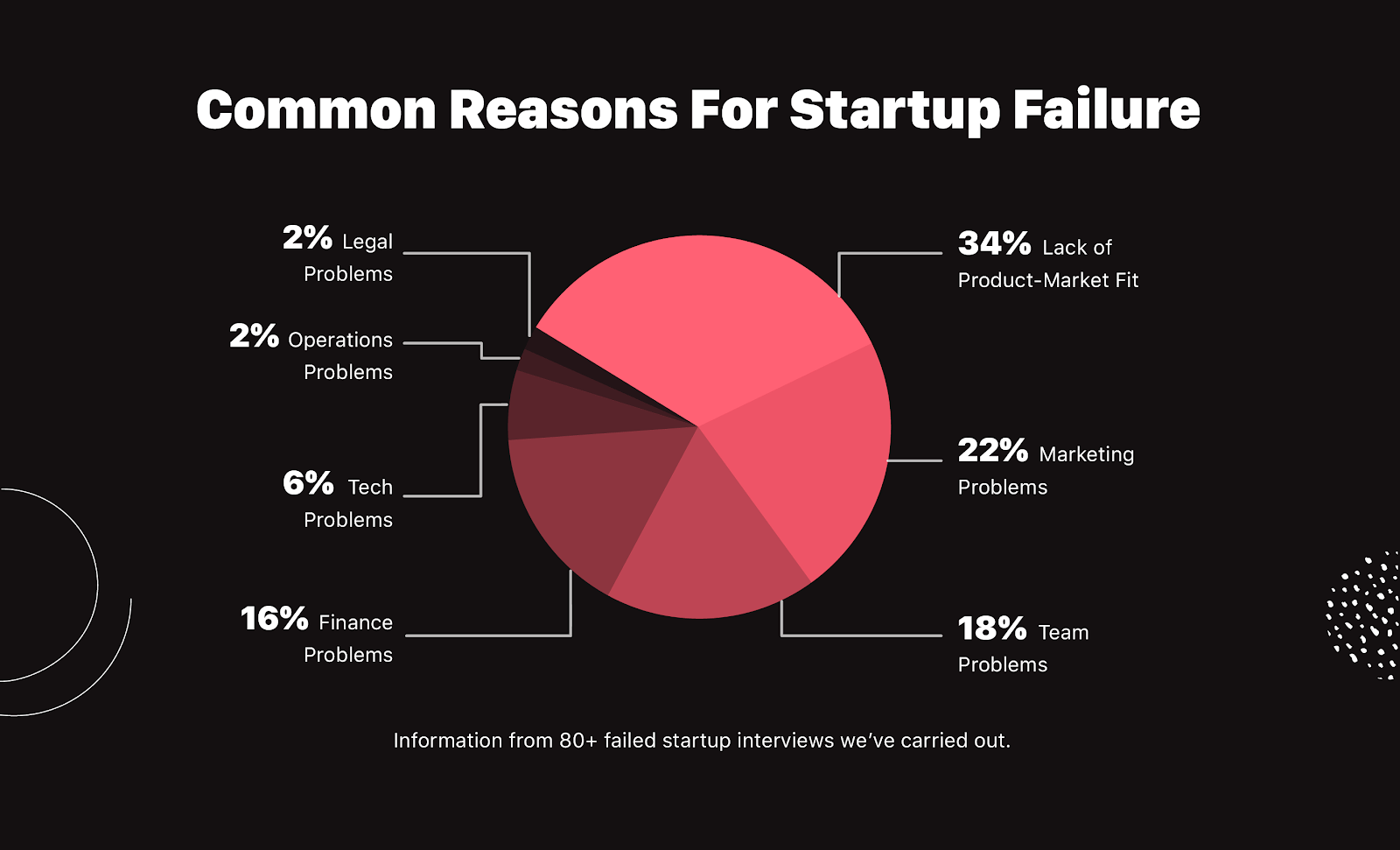Validating your idea is a crucial step for the success of your startup.
In this article, I’ll show you the 4-step framework I’ve used to validate various startup ideas through pre-sales.
Why Validate Startup Ideas?
A startup is, in essence, a business experiment with potential. This means that real startups are prone to failure by definition. They are testing assumptions, and it's very likely these assumptions are wrong.
A few years ago, we carried out a Startup Failure Rate research, and we found out that +90% of startups fail.
Over the years, we’ve interviewed +100 failed startup founders and written +100 analyses on why companies like Vine, MySpace, and Juicero failed.
This has allowed us to identify some common patterns in startup failures. That’s how we’ve come across one of the most shocking startup stats: 34% of startups fail because they lack Product-Market Fit.

Or in other words, 34% of startups fail because they build a product the market doesn’t strongly need or is willing to pay for.
And this is where validation of startup ideas comes in.
The framework I’ll show you in this article will help you validate if the market is willing to pay for your product/service before you invest any effort, time, or capital into the project.
By applying it, you’ll be reducing your chances of failing a 34%. That’s why I think validating startup ideas is important.
3 Paths to Validate Startup Ideas
Many founders run idea validation processes, and yet they end up building products or services that the market doesn’t want.
This happens because their idea validation strategy is contaminated with vanity metrics or false positives.
I’ve studied various paths to validate a startup idea, and I’ve identified only 3 that don’t fall into this trap: customer interview insights, waitlists, and pre-sales.
Customer Interview Insights
This is the most traditional path. It works like this:
- You find people who have the problem your product solves and might be interested in your solution, frequently on social networks, online communities, or events.
- You contact these people and ask them if they’d be fine with doing an interview. If possible, you shouldn’t mention you’re working on your solution.
- You interview the people. You mainly ask questions related to the problem your product aims to solve. Common questions include: How often do you have the problem? Are you actively looking for a solution? How much is the problem costing you?
- After conducting 10-30 interviews, you’ll probably have enough information to decide if your solution is something your interviewees would be willing to pay for and, therefore, if your idea has been validated.
The replies obtained from customer interviews can be a good indicator for idea validation, but only if customer interviews are done with extreme caution, which in most cases doesn’t happen. I’ll talk further about this later.
Waitlists
The first website of most startups is a simple landing page with a newsletter form.
To identify validation, some founders pay attention to the conversion rate from website visitor to newsletter subscriber, amount of subscribers on the waitlist, or open and click rates of the newsletter.
This is a huge mistake - these are all vanity metrics. Subscribing to a waitlist and opening an email has no cost or involvement for the user, so it doesn’t demonstrate any real interest and willingness to pay for the product.
4 better indicators are:
- Feedback from the subscribers: You send an email with updates about the business, and you get many replies from subscribers sharing their thoughts.
- Survey replies: You send a link to a survey, and a high percentage of subscribers (10%-30%) respond to it.
- Willingness to collaborate: You send an email to your subscribers pitching them a customer discovery interview, and the acceptance rate is high.
- Referrals brought by each subscriber: Your subscribers are inviting many people to the waitlist as a way to get earlier access to your product (this applies to viral waitlists only).

Pre-Sales
Pre-selling consists of selling a product or service that hasn’t been built yet.
It’s not a common strategy. In MicroConf’s 2022 State of Independent SaaS report, only 9% of founders claimed to have used this strategy to validate their SaaS idea.

Until recently, many people found it hard to believe that customers would be willing to pay for a product that wasn’t finished. However, the strategy has been popularized by the creators of digital products and is now more frequently used for SaaS and physical products.
Pre-sales generally include some incentives for the customers. Since the product isn’t built and customers have to wait weeks or months to get access to it, the pre-sold products are generally offered at a discounted price or include various bonuses.
In this article, I’ll go over an actionable framework to use pre-sales to validate the market’s need and willingness to pay for your product/service.
“Niceness Gap”: Why You Should Use Pre-Sales
If you believe that a commitment in the form of money is stronger than one in the form of time, you probably agree with me that pre-sales are a stronger idea validation indicator than customer interviews and waitlists.
To back up my point, let me introduce a term called “niceness gap.”
"Niceness gap" refers to the gap in the number of people who will tell you they love your product/service and want to buy it and the actual number of people who will do it.

The reason why waitlists and customer interviews are inferior to pre-sales as an idea validation indicator is because they leave space for the niceness gap.
When doing customer interviews or exchanging emails with waitlist subscribers, most people will be friendly with you and tell you they like what you’re working on. No one wants to disappoint and be harsh on other people.
But people will be nice up to one point: when they have to put out their wallets to pay for your solution. That’s when they’ll suddenly become honest and tell you they aren’t interested in your product/service or that they “will buy it later.”
Pre-sales, instead, leave no space for the niceness gap. If you follow my approach, you don’t care how often people tell you they like your product; if people don’t pre-order, your idea isn’t validated.
My 4-Step Pre-Selling Framework
I’ll now show you how to:
- define your pre-selling campaign,
- build a minimum viable offer,
- pre-sell your MVO,
- and analyze the results.
In 2-8 weeks, you’ll have a validated or unvalidated startup idea.
1) Define a Pre-Selling Goal
The pre-selling goal is what needs to happen to consider your startup idea validated.
Your pre-selling goal should be “SMART”:
- Specific: You need to be really clear on what will validate your idea. Don’t leave space for ambiguous circumstances where you don’t know if you’ve achieved the goal.
- Measurable: Set a specific number of sales or revenue that will validate your idea. You can tell customers that you’ll only be working on the product if you achieve that milestone.
- Achievable: Set a reasonable number of sales or revenue as your goal. Don’t forget we’re using pre-sales to validate the idea, not to get funding to build it or whatever else.
- Relevant: Focus on the number of sales or revenue - ignore other vanity metrics such as website traffic or newsletter subscriptions.
- Time-specific: Define a timeline for your pre-selling experiment. If you don’t achieve your goal by your deadline, your idea isn’t validated. I’ll then go over what you can do in these situations.
You can use the following formula to define your pre-selling goal: "If in [Time] from now I've made [Number] pre-sales, I've validated my business idea."
2) Build a Minimum Viable Offer
A Minimum Viable Offer (MVO) is the simplest offer you can build that’s good enough to make a sale.
MVOs can take a lot of different shapes, including in increasing order of simplicity:
- A basic functional prototype.
- A landing page.
- An explainer video.
- A mockup.
- A document or email explaining the product.
A landing page is the standard. There, you can explain the product/service, include some images or videos showing it, and display a purchase button.
Including visuals can increase your conversion rates a lot. As you haven’t built the product, you can:
- design some simple layouts and take screenshots,
- or animate the layouts so they look functional, and record a video.
This famous demo video of Dropbox went viral and made them go from 5,000 to 75,000 subscribers overnight. It was a fake prototype.
3) Pre-Sell your MVO
There’s an infinite number of strategies you can use to get customers for your MVO.
I’ll go over 10 of these later in the article.
4) Analyze the Results
The final step of this framework is to analyze the results of your pre-selling experiment.
If you’ve achieved the goal, your idea is validated, and you should move on with the development of your product or service, always in a lean way so as to keep validating assumptions that will surge throughout the road.
If you:
- Didn’t achieve your goal but almost did it.
- Didn’t achieve your goals but feel optimistic about the business idea because of your discoveries through the pre-selling experiment
- Couldn’t work on the pre-selling experiment and want to give it another shot.
- Achieved the goal, but you’re still unsure about your business idea.
You can:
- Set a new pre-selling goal and timeline, and run a new experiment.
- Re-define your value proposition, pricing model, or target customer and conduct a new pre-selling experiment.
If you:
- Didn’t achieve your pre-selling goal and didn’t find anything really positive about your business idea.
- Achieved your goal but don’t feel like keep working on the idea (maybe because of what you found out in the pre-selling process).
You should move to your next business idea. Explain what happened to the people who pre-ordered your product or service, if any, and refund them.
10 Strategies to Get Pre-Sales
The hard part of the framework is getting real pre-sales for your product/service.
In this section, I’ll go over the 10 most frequently used strategies to get pre-sales and analyze how other founders have used them.
1) Leverage your Audience
This strategy only works if you already have an audience.
With “audience,” I’m referring to a group of people who follow you (on social networks or your blog) and with whom you communicate through broadcasts rather than personalized messages.
If what you're selling is related to your audience, you can take advantage of your reach and share your MVO with them.
Steph Smith has a Twitter audience of +100k followers. On Twitter, she has been consistently publishing about creating content and growing blogs.
One day she tweeted that she had come across an outline of a 4,000-word guide she had been writing the previous year about creating content and asked her followers if they were willing to pay $10 for the finished version.
Her followers’ response was incredibly positive, so she launched a pre-selling campaign. In less than 24 hours, 86 pre-sales were made, totaling a revenue of $1,270. That’s how she validated her book idea.

2) Build in Public
Building in public consists of transparently sharing the behind scenes of how you build your company or product.
You may share screenshots of your work, business metrics, milestones achieved, clever strategies, etc. The channels frequently used are Twitter, LinkedIn, personal newsletters, niche communities, or streaming platforms (like Twitch).
The idea with building in public is to reach people who are not only interested in your journey but also in buying your product/service. Besides that, transparency builds trust between you and your followers and helps you build status as an expert in your business field, which can generate you many opportunities.
William Candillon took Building in Public to the next level and streamed on Youtube how he developed a UI kit, figuring that even if no one watched, it’d still force him to be productive.
As people started to discover their streams, they started requesting access to his product. He ended up making 95 sales before launch, totaling $3,000 in revenue.
3) Niche Communities / Forums
Niche communities are online places where people with some shared interests hang out. They can take different forms: Slack channels, Discord servers, Telegram groups, Subreddits, etc.
You can interact in these communities to get pre-sales.
- You can do self-promotion and share a link to your product, but in most communities, that’s not accepted.
- You can cold-message members who could benefit from your product.
- You could focus on providing value to other members and let them find your solution in your profile.
Brian Casel used this channel to pre-sell Ops Calendar, a SaaS to manage a content calendar.
He searched various Facebook groups for people asking for solutions or advice around content calendars in the previous 12 months. He found around 20, who he cold-messaged. He got 7 replies, 5 of which turned into calls and, later on, some pre-sales.
4) Publish Content
Create content and distribute it to reach people who might be interested in pre-ordering your product/service. Content can take different forms, like articles, podcasts, videos, and lead magnets.
SEO-focused content won’t work, as it’ll take many months to rank on Google and bring traffic, and you have a tight pre-selling timeline.
Instead, you should focus on creating shareable content. Some ideas:
- Write about trending topics.
- Write about controversial issues.
- Write articles based on data.
- Share a personal story.
- Share others’ stories.
- Create an infographic.
Kalo Yankulov used content to validate his idea for Encharge, a marketing automation SaaS.
He wrote a huge article on how he had launched, marketed, and sold his first SaaS. He then shared it across social networks and online communities. This brought him +3,000 readers and +500 email addresses (people who downloaded a free lead magnet on the article).
2 weeks later, he sent a pre-order lifetime deal to the subscribers. 42 people ordered 50 licenses, generating him $3,950 in revenue.

5) Side-Project Marketing
Side-project marketing, or Engineering as Marketing, consists of creating useful tools, like calculators, directories, quizzes, and widgets to get your company in front of potential customers.
SparkToro used side-project marketing as a pre-launch strategy. They created 3 free tools related to their product and target audience, which they promoted through social media. These tools got them various backlinks and interested people in their product.
6) Guest Posting & Podcast Guesting
Guest posting consists of writing and publishing articles on someone else’s blog as a guest author. Podcast guesting consists of being interviewed on someone else’s podcast.
Your goal is to provide the audience of the blog or the podcast with value and drive interest in your pre-selling product/service. To achieve this, the blog or podcast should be read/listened by your target audience.
I recommend against paid posts/interviews. It’s easy to realize when something is a hidden advertisement.
When pre-selling a service company I built in the remote hiring space, I posted a guest post on the blog of a SaaS that provided HR solutions for global teams. It didn’t drive any pre-sales (at least that I could attribute), but it sent some traffic and generated a backlink.
7) Cold Outreach
Cold outreach is when you contact someone who doesn’t know about you or your business via email or direct message.
You have to contact people who have openly claimed to have the problem that your product/service solves or people with specific characteristics or job duties that make them your target customers.
Some ways to find these leads:
- Find a list of companies with specific characteristics that make them good fits for your company.
- Find a list of people with particular traits who might be interested in your product/service (try Linkedin).
- Find people on niche communities or social networks who have claimed to have the problem your business solves.
- Find your competitors’ customers and steal them.
Stan Rymkiewicz used this strategy when pre-selling Orapa, a pay-per-meeting platform for startups.
He used LinkedIn to find over 100 founders who could be interested in his product and sent them cold emails pitching them Orapa and offering a 60% discount. Many of them bought it.
8) Facebook & Google ADs
With Facebook Ads, you'll target users who are passively looking for something. With Google Ads, you'll target users who are actively looking for something.
For some businesses, reaching people who have already shown interest in their product or service works the best to get an ROI. Other companies find it more profitable to reach people who aren't actively looking for a solution.
Don’t aim to be profitable, anyway. Your goal with these ads is just to validate your idea, so it's okay if you spend more on ads than what you make in pre-sales.
Justin Mares decided to build Kettle and Fire, a bone broth eCommerce, after hearing of bone broth from his Crossfit friends and realizing there was no eCommerce selling it.
He bought the domain “bonebroths.com”, set up a landing page, set a price of $29.99 for 16oz, and purchased $50 of Bing Ads (similar to Google Ads), targeting “bone broth” and related keywords. In 2 weeks, he made $500 in pre-sales.

9) Niche Events
You can either attend or run an offline or online event to connect with people who might have the problems your business solves and convert them into pre-ordering customers.
Jeremy Abraham used this strategy to validate Spiffy, a tool for building checkout pages and taking credit card payments. Spiffy initially only worked on top of Keap, formerly Infusionsoft, which is a CRM, sales, and marketing automation tool.
After coming up with the business idea, Jeremy built some mockups and attended a major industry conference, in which many Keap customers also participated. At the conference, he showed the mockups to various attendees and got his first pre-ordering customers.
10) Leverage Marketplaces
Leverage the user base of a marketplace to get some pre-sales for your unfinished product/service.
For physical products, you could post your product idea on a marketplace, along with some fake images of it, and see if its users buy it. If they do, you cancel the purchase by telling them you're out of stock.
For a service, post your service idea on a service marketplace (Fiver, Upwork) and see if their users request it. If you don’t already have the resources to provide the service, you can cancel it.
Airbnb leveraged marketplaces to validate the demand for their marketplace idea. They posted their renting houses on Craiglist, reaching, in this way, this marketplace's user base and getting their first customers.








